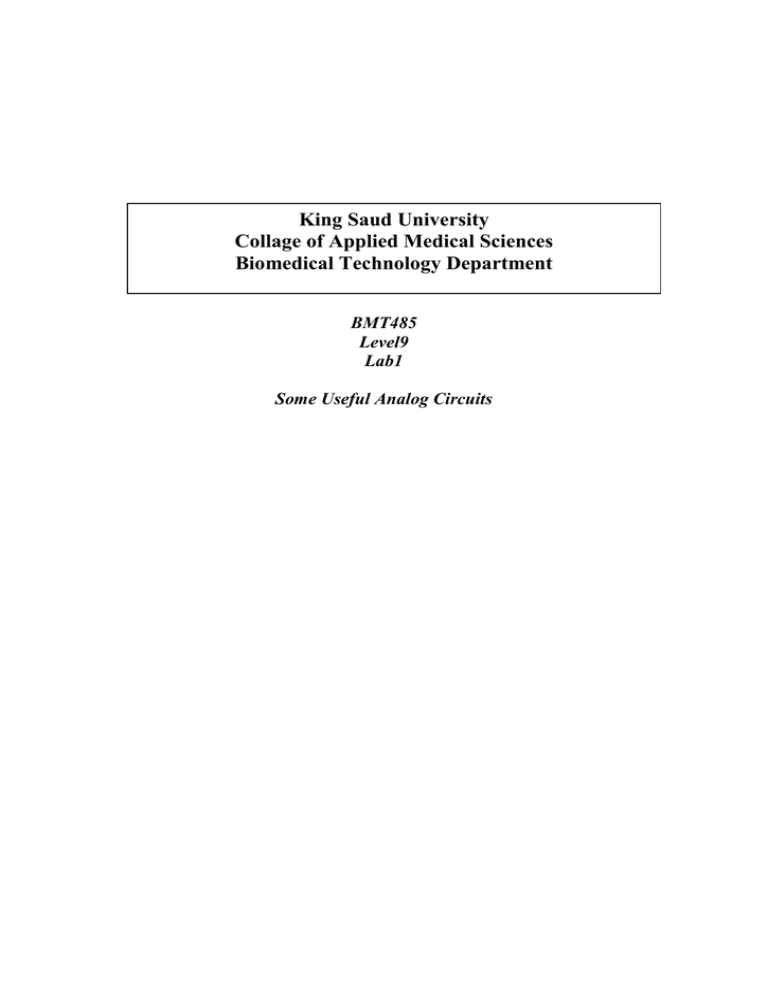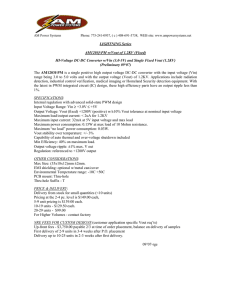BMT485 Lab 1 - Home - KSU Faculty Member websites
advertisement

King Saud University Collage of Applied Medical Sciences Biomedical Technology Department BMT485 Level9 Lab1 Some Useful Analog Circuits Objectives Upon completion of this lab you'll be able to understand the following points 1. Power supply component and a simple design of the power supply 2. Regulation (Line regulation and Load regulation), regulator and regulators types(Linear , switching) 3. Relays (Mechanical, Reed, Solid state ) 4. Oscillation and oscillators types 5. Op-Amp (TL064, TL074, TL084, LM324) and different circuit (summer, Average…), Bipolar transistor (2N3904, 2N3906, BC108) 6. Analog MUX/DEMUX (4051, 4052, 4053) Introduction This lab is a revision on some basic and useful analog circuit that will help us with the next labs and the project, many references will be available on these topics that will help and guide you through this lab and the next labs. Deep understanding of this lab objective is a must because it helps you to decide which circuits are needed for your project design and why you need such a design also it serves as a basic knowledge of some important circuits. Pre-requisite "Subjects to be understood before launch this lab" No special pre-requisites are needed however the measuring skills of current, voltage, and resistance using the multi-meter are must Required equipments Multi-meter Oscilloscope Function generator Experiment steps We are going now to discuss some basic and important circuits all what we need to do is to understand the design and function of these circuits and to setup some of these circuits. Power Supply 4 8 D1 BRIDGE 2 - + 4 U2 78xx R1 R 1 VOUT 3 V0 2 3 C1 C VIN GND 220VAC TRANSFORMER 1 T1 5 1 F1 FUSE Figure 1 Transformers equation V1/V2=N1/N2=I2/I1 Types of transformer Step up Step down Isolation (impedance matching) Regulation and regulators Line Regulation Can be defined as the percentage change in the output voltage for a given change in the input line voltage Line Reg = (Δ Vout/Vout) / Δ Vin *100% Load Regulation Can be defined as the percentage change in the output voltage for a given change in the load current Load Reg = (Vnl-Vfl)/Vfl *100% Types of regulators Regulators Switching Linear Series Up Shunt Down Inverting Figure 2 Regulators A voltage regulator provide a constant dc-output voltage independent of the input voltage output load current and temperature Regulator 79XX (Negative regulator) regulator) Regulator 78XX (Positive U3 U2 78xx 79XX 3 1 VIN VOUT 2 GND VOUT GND VIN 1 2 Figure 3 3 Relays Types of relays Relays Mechanical Reed Solid Figure 4 A relay is a device that interfaces the high voltage AC to microcomputer (low power or low voltage devices). The control circuitry for a relay is electrically isolated from the actual switch this is very important to protect the PC from short circuit with the high voltage AC Mechanical relay 4 3 1 2 RELAY SPST Figure 5 Mechanical relays are called contactors they are suffered from 1. Mechanical contact degraded so increasing the contact resistance 2. EMI interference because switching could happen at any part of the AC cycle. 3. Arcing that result from switching on the relay coil Reed relay Almost as the mechanical relays except it could handle less current in the coil Solid state relay VAC +5VDC R1 R2 D2 TRIAC LED A B C Q1 C1 Solid State Relay From PC 3 R3 2 Q2 1 2N3904 L1 Heater Figure 6 A=Phototransistor B=Zero-crossing Detector C=Trigger CKT D="Consist of R2 and C1" Snubber circuit When the switch is on "Q2" light from the LED D2 is forced on "A" then through "B" and the trigger circuit firing the TRIAC at a point near zero to conduct 110/220VAC to a coil or heater. There are several thousand volt of isolation between the input circuitry and the output circuitry. The relay is turned off when the current of the TRIAC is fall below certain current ( I hold) and if we require it on again so fast it won't conduct until the next cycle of the AC current at a point so near to zero so minimizing EMI interference. Solid state relay problems 1. So expensive 2. When driving a large inductive load like motors at the turn off the back EMF is so large across the TRIAC and may result in turn it on at a time we don't want it to. So using the snubber circuit "D" to reduce this back EMF Oscillation and oscillators types Oscillators are circuits that generate an output signal with out an input signal Different types of oscillators produce various types of out puts including sine, square, and triangular waves Oscillation operation is based on the principle of the positive feed back. When apportion of the output signal is feedback to the input in away that cause it to reinforce and thus sustain a continuous output signal Condition for oscillation 1. Phase shift around the feedback loop must be zero 2. the voltage gain around the closed feedback loop must be unity RC-circuit that produce sine wave 4 5 R1 3 TL081 6 + 7 1 2 - R2 C1 R3 C2 Figure 7 Vout = (1+R1/R2) Vin If R4=R3=R and C1=C2=C Fr=1/2πR3C1=1/2πRC The 555 timer as an oscillator A stable +5VDC 4 8 R1 RESET 7 R2 6 2 Cext VCC DISCHARGE THRESHOLD OUTPUT 3 Vout TRIGGER GND CONTROL 1 5 555 C1 0.01uF Figure 8 Fr=1.44/(R1+2R2)Cext D.C=(R1+R2)/(R1+2R2) R4 Vout In order to achieve duty cycle of less than 50% use the following connection +5VDC 4 8 R1 RESET 7 D1 R2 VCC DISCHARGE 6 THRESHOLD OUTPUT 2 3 Vout TRIGGER GND CONTROL Cext 5 555 1 C1 0.01uF Figure 9 D.C=R1/(R1+R2) Voltage Controlled Oscillator "VCO" +5VDC 4 8 R1 RESET 7 D1 R2 6 2 Cext VCC DISCHARGE THRESHOLD OUTPUT 3 Vout 5 Vcontroll TRIGGER GND CONTROL 1 555 Figure 10 When the control voltage is varied the output frequency also varied. An increase in Vcontroll increasing the charging and discharging time of the external cap Cext causes the frequency to decrease. A decrease in Vcontroll decreases the charging and discharging time of the external cap Cext causes the frequency to increase Op-Amp Bipolar transistor (TL064, TL074, TL084, LM324) and different circuit (summer, Average …), Bipolar transistor (2N3904, 2N3906, BC108) Figure 11 R1 3K R1 R4 1K Vin1 Vout 6 4 5 Vin2 2 +5VDC +12VDC LED R1 1K Vout 3 2 3 +12VDC D1 Vin 1K 7 1 R2 7 1 3 R3 1K U2 TL081 + 1K -12VDC + 2 - Vin Vin3 - 4 5 -12VDC R2 1K Q1 1 BC108 Figure 12 U3 TL081 6 Vout Analog MUX/DEMUX (4051, 4052, 4053) 4051 is a Single8-ChannelAnalogMultiplexer/Demultiplexer 4052 is a Dual4-ChannelAnalogMultiplexer/Demultiplexer 4053 is a Triple2-ChannelAnalogMultiplexer/Demultiplexer U7 U6 13 14 15 12 1 5 2 4 6 11 10 9 X0 X1 X2 X3 X4 X5 X6 X7 INH A B C X 3 12 14 15 11 1 5 2 4 6 10 9 X0 X1 X2 X3 U8 X Y Y0 Y1 Y2 Y3 INH A B 4052 4051 13 12 13 3 2 1 5 3 6 11 10 9 X0 X1 X Y Y0 Y1 Z Z0 Z1 INH A B C 4053 Figure 13 Experiment results and further discussion As we can noticed from the above discussion we have some basic circuits that we can use it as primitives in functional block diagram design. The main goal of this lab is to understand their function how to design it and to use it in different design situations 14 15 4 Take-home assignment 1. Use an electronic simulation program such as EWB or OrCAD and simulate the result of Fig7 and record the components values and the output simulated results 2. What are the difference between the bipolar transistor and JFET? State which one has a faster switching time? 3. If you design an ECG board how would you design the Lead selector circuit? Draw a schematic of your design? 4. What is the relationship between the transformer size and the applied frequency? Explain?



